

This sacred area, about 450 miles south of Cairo on the east side of the Nile, had a small shrine to local deity during the 12th Dynasty. However, it developed over a period of about 2000 years into an enormous complex dedicated to the king of the Egyptian gods:Amon-Ra. It was trashed twice--by Akhenaten and by the early Christians--and is still being excavated with parts of earlier buildings found as building rubble in later additions.Statue of Amon |
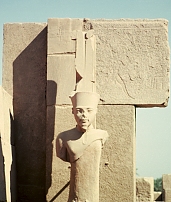 | |
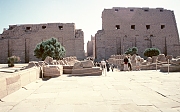
|
A procession of criosphinxes (ram-headed) define the main entrance; these symbolize Amon, the patron deity of the pharaoh. They have sun discs on their heads and the mummified form of Ramses II between their forepaws. The sphinxes were moved here, having been placed originally before the entryway to the second pylon. | |
| In approaching from the front we actually reverse the chronological order of the additions to the temple. This huge pylon was completed under the Ptolemies in about the 7th century BCE. | ||
| This pylon, about 143 feet high, is nearly twice the size of the entrance pylon at Luxor. | 
|
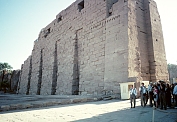 |
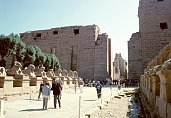
|
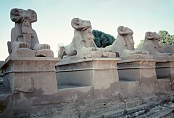
|
The avenue of criosphinxes |
The avenue of criosphinxes |
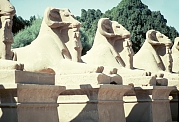
|
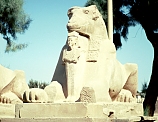
|
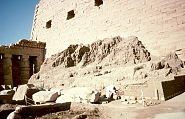
|
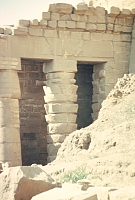
|
The inner wall of the first pylon and cornerRemnants of the brick ramps still exist which allowed the stones to be placed in position. The unfinished column (right) shows that columns were shaped in situ and from the top downwards. |
The first courtyard was built during the 22nd Dynasty (945-745 BCE). At about 9000 square feet, it is the largest courtyard of all the Egyptian temples. There are 18 columns to the left and 9 on the right shaped liked closed papyrus (or buds). The temple of Seti II is on the left with 3 chambers, the central one dedicated to Amon and the sides to Mut and Khonsu. On the right, at right angles to the courtyard, is the Temple of Ramses III (not pictured).The first courtyard with the Shrine of Seti II (left and center) | ||
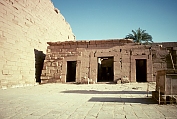
|

|
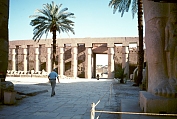
|
| Originally two statues of Ramses II had flanked the entrance to the hypostyle hall. One, almost 50 feet tall, still exists; his Queen is at his feet. | ||
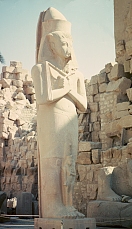
|
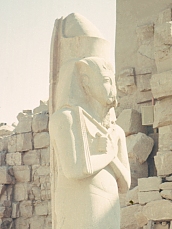
|
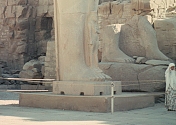
|
 Click here to go to the Egypt Index.
Click here to go to the Egypt Index.
 Click here to return to index of art historical sites.
Click here to return to index of art historical sites.
 Click here to return to index of artists and architects.
Click here to return to index of artists and architects.
 Click here to return to chronological index.
Click here to return to chronological index.
 Click here to see the home page of Bluffton College.
Click here to see the home page of Bluffton College.
